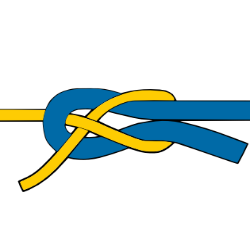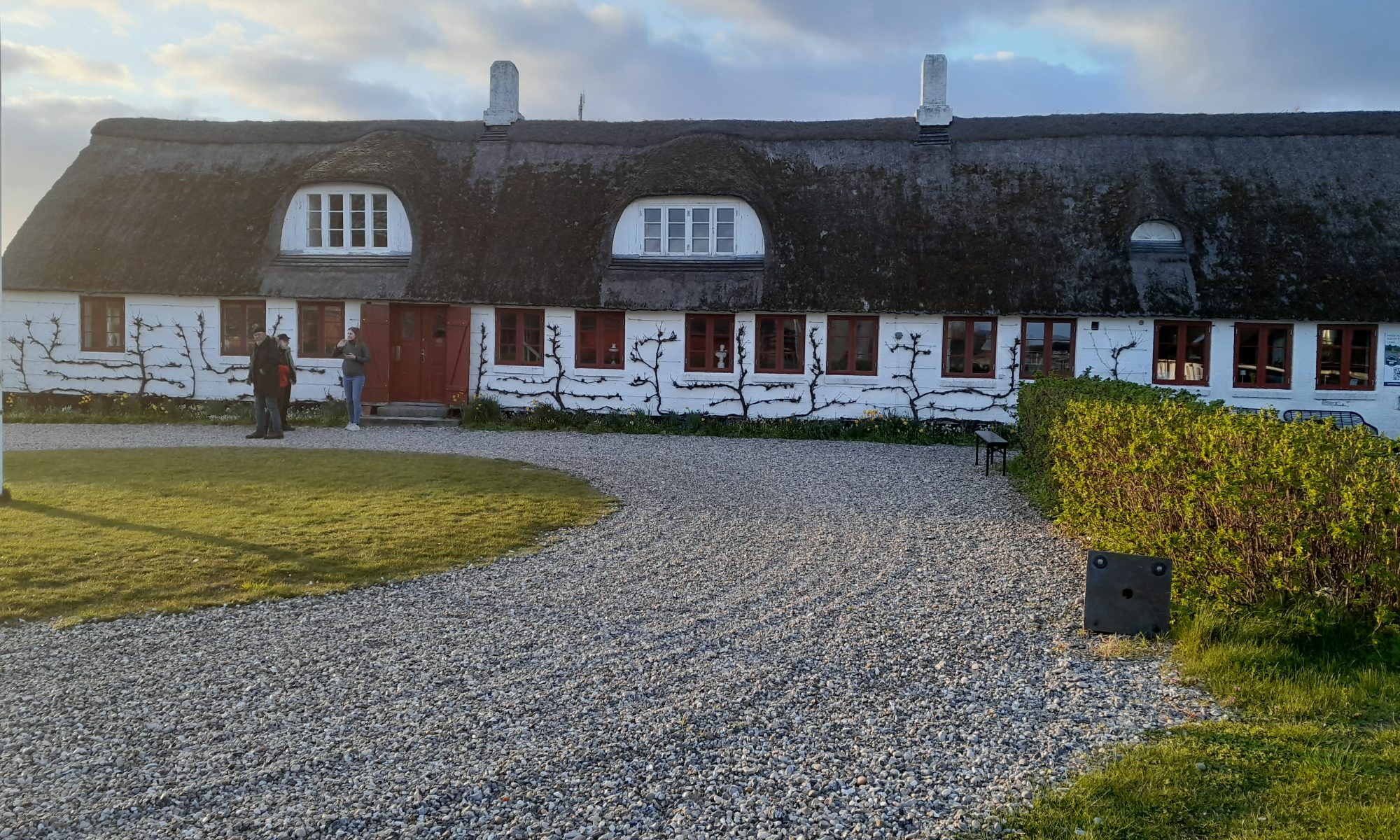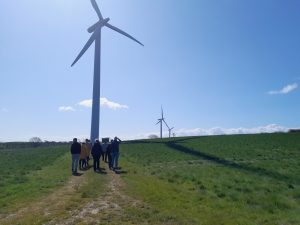So the study trip to Samsö has begun. Here is continuous reporting during the journey in reverse chronological order, so the most recent notes come first.
2023-04-28 09:40
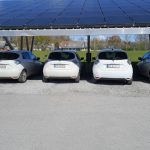 The next stop on yesterday's tour of Samsö was at the Municipal Office. Here, Michael told about how the municipality installed solar panels and is now completely self-sufficient in electricity for the municipal office and that they now have a fleet of 20 electric cars for the municipality's home service that are charged with solar electricity. Introducing electric cars was not simple as there were no service opportunities on the island. But by quickly building up the car fleet, there were enough cars for a car company with a workshop to have car sales and train staff to service electric cars and build up a stock of spare parts. This means that the vehicles can both be bought/leased and serviced on the island.
The next stop on yesterday's tour of Samsö was at the Municipal Office. Here, Michael told about how the municipality installed solar panels and is now completely self-sufficient in electricity for the municipal office and that they now have a fleet of 20 electric cars for the municipality's home service that are charged with solar electricity. Introducing electric cars was not simple as there were no service opportunities on the island. But by quickly building up the car fleet, there were enough cars for a car company with a workshop to have car sales and train staff to service electric cars and build up a stock of spare parts. This means that the vehicles can both be bought/leased and serviced on the island.
Next to the municipal office is one of the island's football pitches. Here, it has been possible to stop using artificial fertilizers by planting approx. 15% of the surface with a particularly effective nitrogen-fixing clover. Furthermore, water with purified waste water instead of drinking water. Other nutrition is supplied from pressed seaweed, which is spread when it is cool in early spring. The pressed seaweed is brownish and effectively absorbs heat from the sunlight and raises the temperature of the soil so that the growth period of the grass increases. The same system is also used on a nearby golf course, where they also have grazing sheep to keep the rough on the course down.
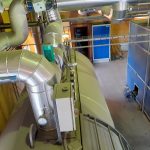 The next stop was at a similar mini-heating plant that we looked at in the northern part of Samsö. The difference between the heating plants is that this heating plant has no solar collector system for preheating the water and this is only fired with straw. Straw has approximately one-third the energy content/unit weight compared to oil but only costs one-sixth compared to oil and this means that the fuel cost is only one-third compared to oil. This power plant supplies properties within a radius of 3 km with district heating.
The next stop was at a similar mini-heating plant that we looked at in the northern part of Samsö. The difference between the heating plants is that this heating plant has no solar collector system for preheating the water and this is only fired with straw. Straw has approximately one-third the energy content/unit weight compared to oil but only costs one-sixth compared to oil and this means that the fuel cost is only one-third compared to oil. This power plant supplies properties within a radius of 3 km with district heating.
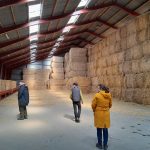
Here, too, you have isolated tanks as redundancy. There are two pieces, which together contain 800 kbm. They are enough to provide district heating for about 2 days in the event of a malfunction. About 25-30 bales of straw are consumed per day in winter and about 18-20 bales in summer, when much of the district heating is used to heat hot water.
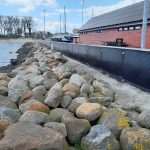
The last stop on the round trip was down in Ballen's gästhamn. A solar cell installation has been installed there, which supplies the guest port with solar energy. In the harbor there are 360 different electrical outlets that can all be turned on and off independently of each other. In the harbor there is also the possibility for visitors to rent an electric car or electric bicycle, which are charged with solar electricity from the facility. All buildings in the harbor are also supplied with electricity from the facility. The plant is supplemented with a battery system with three batteries to even out the consumption so that excess production can be saved in the batteries and withdrawn from those evenings and nights when no production of solar electricity takes place. The entire facility is automated and controlled by a computer system. A boat guest who wants power downloads an app on the phone and scans a QR code for the location's power outlet and pays online with a card, after which the power outlet is activated. The rental of electric cars and bicycles also works in the same way. When the rent is paid, the car/bike is unlocked. After you have disconnected the electric cable and the car/bike can be started and you can drive away. The shortest rental time is 30 minutes and costs DKK 60 for a car and DKK 10 for a bicycle.
2023-04-27 22:30
Today's program included a tour of Samsö with b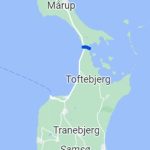 evisit exciting historical places such as Viking canals, heights and fishing communities, but also many interesting onesenergy and environmental facilities. Much of what we got to see is reported with pictures.
evisit exciting historical places such as Viking canals, heights and fishing communities, but also many interesting onesenergy and environmental facilities. Much of what we got to see is reported with pictures.
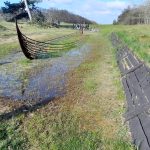
We went by bus from EA and the first stop vis a elevatortorisk place where Vikings built a canal straight through Samsö's narrowest point (see picture). Here haver man docillustrated this with a stylized Viking ship and showed the edge shoeing of oak that supported the sides of the canal.
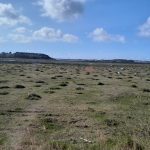
The journey continued past an area that has been untouched since the Ice Age except for grazing. Here you can see how the melting ice left rocks on the flat plain. The land is low-lying and close to the sea. The area floods from time to time. Sheep graze the area today.
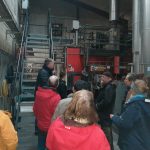
Now we are approaching the first location for real study visits. It was a small local district heating plant. It supplies both villages Norrby and Mårup with district heating. Here, they have chosen to use a combination of solar heat and wood chips. The facility consists of a stor solar thermal park combined with a heating boiler that is fired with wood chips. As a backup, there is an oil-fired boiler. To store heat and create redundancy, heated water is stored in a 350 kbm insulated storage tank. The solar collectors preheat the circulating water by 40-50 degrees in summer and by about 20 degrees in winter. The return water in the remote system has a temperature of about 40 degrees and is preheated by flue gases in a heat exchanger to about 60 degrees. This means that the wood-fired heating boiler only heats the district heating water from about 60 degrees to 80 degrees. For long periods in summer, the boiler is not fired more than for short periods every day.
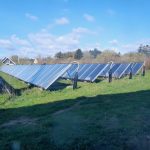
The facility is largely helt automatic. Normal supervision looks once a week ellyou in case of alarm. Om a serious operational disruption occurs, the storage tank is enough for 2-3 days to keep the villages running with district heating before the backup system has to be started. However, you can't do that without a backup startakes after about six hours so as not to empty the storage tank of heat and keep the original.
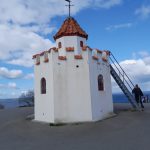
The bus journey continued north to the highest point on Samsö, which is called Norrbybjerg. Here is a litet monument with a visitor's place. It was built in the 1920s and renovated in 2013. Here you can see one of the off-shore wind farms that exist. Norrbybejerg is also a well-visited tourist spot with great views around Samsö.
Next, a stop was made in Norrby, where the EU has classified its center as one of the EU's oldest preserved built-up areas. The entire village core is protected and must not be changed. The village center consists partly of half-timbered houses with thatched roofs or brick skins with tiled roofs without overhangs. In the middle of the old village there is a pond which also functioned as a fire pond.
The houses are still being renovated today. A reed roof lasts about 40-50 years on the south side and about 80-100 years on the north side. There are companies that specialize in renovating thatched roofs. The cost over time is comparable to tile roofs.
More about today's experiences will come tomorrow.
2023-04-26 20:30
After lunch there was a workshop led by EA's CEO Sören Hermansen. The theme was "Capturing the reason for the energy island". Sören began by presenting the REI project and some of its subsequent development projects.
REI
Within REI, a guide was developed "Here" for how the process can be carried out.
The basis is the English concept “Commonites = Commons + community”
Imagine a ship heading forward. The activity is the engine that propels the ship forward. At the same time, a lot of side effects occur with surge waves, side turbulence in the water and a back current in the stern and the propeller current behind the ship. All of these side effects contain energy that should be harnessed. A well-functioning society can take advantage of similar side effects of a business, e.g. service and maintenance for the business, real estate companies for housing, shops for food, clothing, etc. to personnel who carry out the business etc. Here it is important to both see what the side effects are and have good methods to make use of these.
Language and conversation are important.
Man exists in language, conversation, stories and narrative.
Humans shape their world with words, conversations and activities.
Organizations are networks of conversations about commitment to perform activities.
EA ran a project via an energy association, which ran a project to reduce energy consumption and emissions by changing individual oil and coal-fired heating plants to district heating. Households that joined paid SEK 100/household + ongoing operating costs, interest and amortization. The association got a cheap loan because the municipality guaranteed the loan. 85% of the households were included. The investment was paid for and amortized in 10 years. Today, these households only have the ongoing operating costs, which are considerably lower than with their own plant.
Two approaches
- We have a plan and want to do this. You get a finished concept in your face.
- We have a problem and are looking into how to fix it. We think this can be a solution. You get a suggestion to
Challenge
Historically, Samsö is divided into a number of parishes with churches from the Middle Ages, around the 1100th century, and to this day there are social and dialectal differences between these areas, which has created difficulties in forming unity and consensus. That has been one of the project's challenges.
Summary
Power without love is harsh and merciless
Love without power is sentimental
It is important to create working groups so that everyone can have a say. It is important to present a project so that everyone gets something out of it.
A sustainable and robust society must share locality, activities and mentality!
Vision Samsö 2.0, among other things, Fossil free, Self-sufficient in green and
200% energy supply.
Reflection
This was followed by a conversation where the participants sat in a circle and shared reflections on Sören's presentation.
Project discussion
Alexis then presented the project program that Green Island's secretariat will manage. Questions and discussion followed about how a project can be set up and formulated. Various project ideas were aired.
The day's activities ended with a joint dinner at Köpmansgården's restaurant. As a starter, stone-bitten roe was served, as a main course cod loin and for dessert panacotta with rhubarb compote and coffee/tea for those who wanted.
2023-04-26 13:00
After the briefing at EA, there was a visit to a nearby agricultural company, which also produced electricity with both solar cells and wind power. The company had Angus cows and, in addition to hay and concentrate, also cultivated canola and lentils.
The company had solar cells in the barn and machine hall and a cogeneration plant. The production is primarily for own needs. However, they are currently not interested in producing biogas or investing in facilities to store electricity. Instead, you work to control production so you can sell surplus when the price is high. We visited the wind turbine, which at the time produced approx. 800 kW at approx. 10-12 m/s wind strength. The power plant produces approx. 280 MW/year.
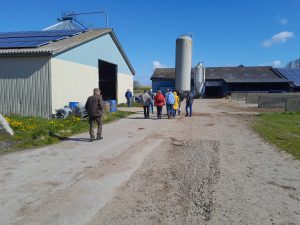
2023-04-26 12:10
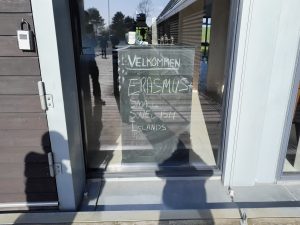
The day began at Samsö Energy Academy (EA) dis Michael and Alexis told about EA's business. Work at EA began in the 1990s with "Samsø's Renewable Energy Island project" (REI). This project has now been developed and is currently operated by EA about 10 development projects partly about energy production and partly about sustainable social development in communities on small islands.
An important aspect is to create the sustainable society by creating participation for the local population. It has proven to be a success factor. A lot of work is put into engaging local politicians and arranging meetings where local people can participate and influence and be kept informed and involved. A guide has been developed for how this work can be carried out.
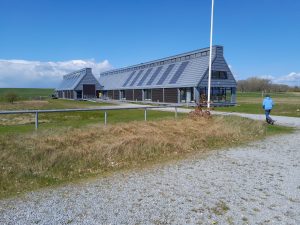
They cooperate, among other things, with Samsö Energi, which manages the electricity distribution at Samsö. Many production facilities are owned by small agricultural companies or private individuals, as co-owners. These facilities deliver to the grid via Samsö Energi and those who are part owners receive dividends on their shares.
Samsö is the only cowmmun in Denmark where the average age is falling as young families are attracted to move out to the island. REI has been a contributing factor to this. Some of the results of the project are that they try to help young families, where one has got a job, so that the other also gets work. There are also rental properties with low rent for those who want to try moving out. They can initially rent there and see if Samsölifet fits.
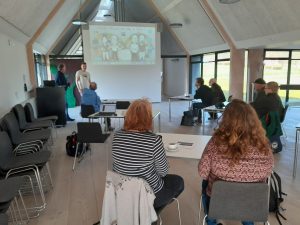
Another outcome of the project is healthcare. There is no hospital on Samsö, but there is a 15-minute ferry connection (no cars) with the mainland to the west with public transport at the ferry terminal for, among other things, medical care in Aarhus. There is a collaboration with the hospital so that care times are synchronized with the ferry's itinerary so that you can go in the morning and be home again after lunch after a care visit.
In 2015, a gas-powered ferry was introduced for transport to the mainland in the west to the town of Hou just south of Århus. The ferry is powered by liquid biogas. Initially, you have to import the gas from Rotterdam, but a development project exists to produce biogas at Samsö. For communication to the east, a completely new port was built at Ballen and was thus able to shorten travel time and reduce emissions of sulfur dioxide by 20%. Electric ferry traffic will be introduced on that route by 2025 to completely reduce emissions. It is expected to build two electric ferries that take 120 cars, compared to today's ferry that takes 160 cars. It is also expected to establish a direct route to Aarhus in the west. It is double the distance towards the route to Hou. All ferries must be powered by renewable fuels. The government plans for a bridge connection between Kalundborg and Hou via Samsö. On Samsö, people are not positive about this, partly for environmental reasons, but also because the island community will change for the worse if there is a bridge connection.
EA also works, among other things, with energy consultancy. They organize various trainings, like this one, and receive many delegations from islands all over Europe. They receive thousands of visitors every year. EA is also involved in the secretariat of the EU's Green Island programme.
2023-04-25 23:15
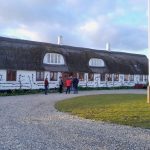
Once at Samsö, we were met by Alexis et al and driven to Købmangården, where we will stay and eat both breakfast and dinner. Since we were only 10 pax participating, everyone could be accommodated in single rooms. Købmangården is an old house with thick mudstone walls and a thatched roof.
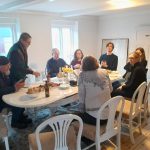
Here drawtwe were treated to a lovely Danish buffet with charcuterie, cheeses, various spelled vegetables, grapes and olives. Various local beers and wine were served with it. The group was inquisitive and Alexis had to answer a lot of questions before it was time for him to leave for home. The group continued the discussions and chose to have a reasonably late evening. Tomorrow the real adventures await.
2023-04-25 19:05 p.m
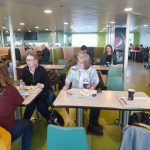
There went vi ombord on the ferry to Samsö. The ferry journey took 1 ½ hours and dinner pherbwas taken on board. The project offered dinner and it was just a matter of choosing the food. Alcoholic drinks had to be paid for by everyone. Many interesting and pleasant conversations took place on board.
2023-04-25 16:50
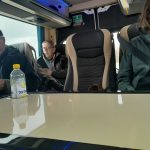
During the day, all participants have individually traveled to Malmö eller Kastrup. After a lot of back and forth, we finally became 10 interested individuals who had the opportunity to come along on the trip. A Bus picked up under em and now we leave around 1 o'clockm travel with med the bus to Kalundborg.



Funded by the European Union. The views and opinions expressed are solely those of the author[s] and do not represent the official position of the European Union or the European Education and Culture Executive Agency (EACEA). Neither the European Union nor the EACEA takes any responsibility for these.

